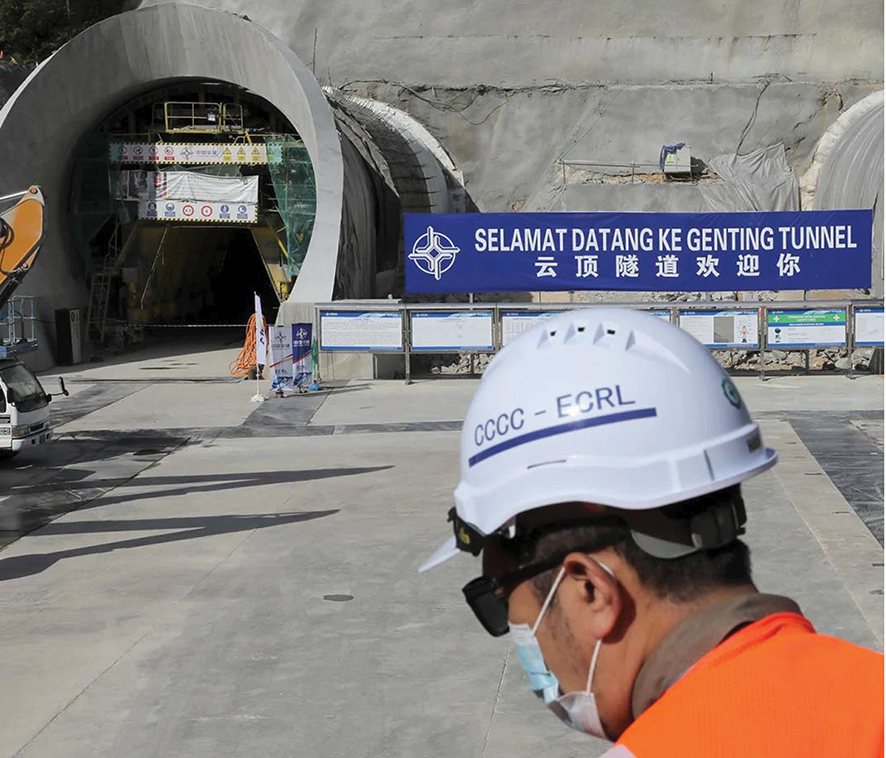The 10,000th, fully-loaded freight train from China to Europe arrived in Hamburg, the EU’s largest rail-port, in mid-September last year. But while local officials stationed to welcome the train after its eighteen-day journey across Eurasia feted the potential of cross-continental shipping, rail executives grumbled that China-Europe rail volumes would take years to restore following the disruptions caused by Russia’s war against Ukraine.
Flows across the Northern Corridor, the rail transport route between Europe and China that runs through Russia, are indeed down: The German Institute for International and Security Affairs estimated in late October 2022 that traffic had decreased by as much as 40%. But tempering pessimism about the future of long-haul dryland shipping between the EU and China is the potential of the Middle Corridor – a hybrid rail and sea route which traverses Central Asia, the Black and Caspian Seas, and the South Caucasus, cutting Russia out of the equation. Mulled over for years, there has been little serious drive to develop the route, but the war in Ukraine and Covid are changing that, and Georgia, as one of the four main countries that comprise the corridor, stands to benefit greatly.
One door closes
Though rail currently plays just a small part in China-EU trade – equivalent to approximately 4.5% of the 32.8 million TEUs that crossed between China and the EU in 2021 via maritime routes – interest in and flows along the Middle Corridor are surging.
China provided initial momentum for the Middle Corridor in the mid-2010s as part of its ambitious Belt and Road Initiative (BRI). While enthusiasm was abundant, skepticism was too; China’s large-scale infrastructure projects abroad have often given rise to unsustainable debt crises in host countries. The Chinese Communist Party may have admitted as much at its recent party congress in October, where the new Chinese Global Development Initiative (GDI) looks poised not to phase out the BRI, but to attempt to mollify the criticisms of predatory lending leveraged against it by shifting to a co-financing approach in foreign infrastructure projects. The threadbare state of infrastructure along the proposed corridor and geopolitical concerns of ‘angering the Russian bear’ further dampened excitement.
Lack of coordination between states that comprise the route makes it difficult to assess the exact volume of throughput, but freight transport between Azerbaijan and Kazakhstan was up nearly 800% in the first ten months of 2022, an Azerbaijan Railways subsidiary reported in November. The Trans-Caspian International Transport Route Association said it was expecting 600% growth in cargo volume along the entirety of the route for 2022. On a smaller but still impressive note, a TBC Capital report from November 2022 noted that ‘cargo transportation volumes [in Georgia] are expected to [have increased] by 32% YoY in 2022’ and annual growth in the transportation and storage sector, responsible for roughly 5.5% of Georgia’s GDP, was expected to reach 22%. There has also been an uptick in large logistics providers who have begun using the Middle Corridor, including giants such as Maersk, Rail Bridge Cargo, and CEVA Logistics.
If you (can) build it
A Middle Corridor which could compete for traffic with its northern neighbor faces numerous obstacles. Georgian and other regional ports already worked at near peak capacity in 2022 due to the surge in throughput, with the EBRD estimating that 80,000 TEUs will have traversed the Middle Corridor in 2022, ‘not far from its maximum throughput capacity of 100-120,000 TEUs.’ The EBRD says throughput along the route will be constrained by the limited number of vessels in the Caspian Sea and non-regular shipment schedules. Capacity in Black Sea and Caspian Sea ports like Poti, Batumi, Baku, and Aktau will also need to significantly increase, while rail infrastructure up and down the line requires upgrades.
Increased flows along the Middle Corridor are first and foremost a result of disruptions along Russia’s Northern Corridor. Though sanctions against Russia have not explicitly forbidden rail transport through the country, logistics providers have been scared off and are looking for alternative solutions. Covid’s impact on maritime trade in recent years also presented an opportunity for dry-land; sea container prices were up multiples of three and four in 2021 and 2022, making rail transit, previously viewed as formidably expensive, suddenly quite affordable. While rates for maritime freight have since corrected, the blip impressed upon logistics providers the necessity of diversification.
To meet these needs, the IFI says approximately 3.5 billion euros ($3.7 billion) in immediate investments will have to be mobilized along the Middle Corridor if growth is to continue apace. In earlier years, China showed considerable willingness to invest in large-scale infrastructure projects as part of the Belt and Road Initiative, though it has been conspicuously absent since Covid. Fortunately, several IFIs have already signaled they are interested in picking up the slack to back the Middle Corridor financially.
Meanwhile, the political lead on the corridor has been taken up by Turkey and Kazakhstan. Turkey has even coined its own label for the route: the Trans-Caspian International Transport Route. Turkey’s push for the development of the corridor coincides with other geopolitical processes in the region, including the opportunity to decrease Turkic states’ reliance on Russia and China and the potential development of the Zengazur corridor, which would link Azerbaijan with its Turkey-bordering exclave, Nakhchivan.
Georgia has thrown its weight behind the movement as well, joining at the end of March 2022 the Declaration on the Trans-Caspian East-West Middle Corridor, which focuses on the ‘importance of the Baku-Tbilisi-Kars railway in promoting competitive transport between Europe and Asia.’ The same declaration noted the importance of completing construction works along the railway line to increase its carrying capacity. In late November, Georgian, Azerbaijani, Turkish, and Kazakh ministers met to discuss trans-Caspian connectivity in Aktau, Kazakhstan and signed a roadmap to overcome barriers along the route. More recently at Davos, Georgian Prime Minister Irakli Garibashvili reaffirmed Georgia’s interest in cooperating with Azerbaijan, Kazakhstan, and Turkey, noting “the chemistry is there, and we have a strong foundation to work together.”
There is already considerable talk of plans for port expansion and infrastructure improvement in the region. Baku Port says it will begin an expansion project in 2023, “increasing cargo traffic volume to 25 million tons per year and 500,000 TEU containers,” a port official told reporters in November. Kazakhstan’s only port, Aktau, plans to build a new $28.9 million container hub by 2025, increasing capacity from 40,000 TEU to 215,000 TEU annually. Georgian PM Garibashvili, again at Davos, announced that Azerbaijan was committing additional funding to upgrade the Baku-Tbilisi-Kars railway, “which will [add capacity for] another 5 million tonnes of cargo.” Upgrades to the rest of the country’s ports on the Black Sea coast remain under discussion.

False or running start?
Whether or not interest in the Middle Corridor proves enduring in the long run depends on multiple factors. Interest in the route has picked up just as the global economy is facing the prospect of a recession: the World Bank recently slashed its expectation for global economic growth from 3% to 1.7% for 2023, while inflation concerns continue to dissuade consumer spending, despite signs it may be starting to let up. This slowdown in demand for goods will likely cause a slowdown in the logistics industry, which is already experiencing a slump.
The stabilization of maritime shipping rates, down from their Covid-highs of nearly $10,000 per forty-foot equivalent to just over $2,100 (Drewry World Container Index – Composite, mid-January) will also cast doubt on the need for an additional land route. As China continues on its quick and chaotic reopening to the world, the squeeze at ports is expected to let up in the coming months, which may cause interest in rail to drift back out to sea. Georgian Railway voiced exactly these concerns to TBC Capital, questioning the stability of demand in the future and noting that this would be a serious investment barrier to overcoming shortfalls of rolling stock.
Snapshot of China-Europe rail. Source: Eurasian Rail Alliance Index
Between 2016-2021, the number of annual China-Europe freight train voyages increased from 1,702 to 15,183, with an average annual growth rate of 55%.
Annual value of goods increased from $8 billion in 2016 to $74.9 billion in 2021.
For every four trains headed to China, five leave for Europe.
1.46 million TEUs were transported via the China-Europe rail network in 2021 (China National Railway Group)
Rail freight shipped between China and Europe in 2021 was 4.45% of total Asia-Europe ocean containerized trade of 32.8 million TEUs.
The Middle Corridor handled about 80,000 TEUs in 2021, roughly 5%, of Asia-Europe rail traffic
Concerns of economic viability aside, the Middle Corridor may prove its mettle by virtue of its not being its northern neighbor, as logistics providers will continue to seek insurance against disruptions in the future. Moreover, the European Union is moving quickly to diversify and secure better energy, communications, and transport connections with the South Caucasus and Central Asia. While in the long run the Middle Corridor is unlikely to prove itself a less expensive option than the Northern Corridor, it does have the opportunity to show that it is more reliable.
By the Editorial Board of Investor.ge














